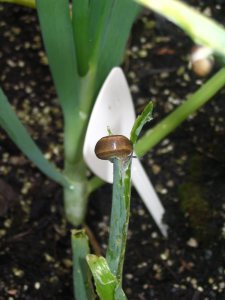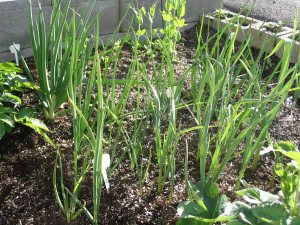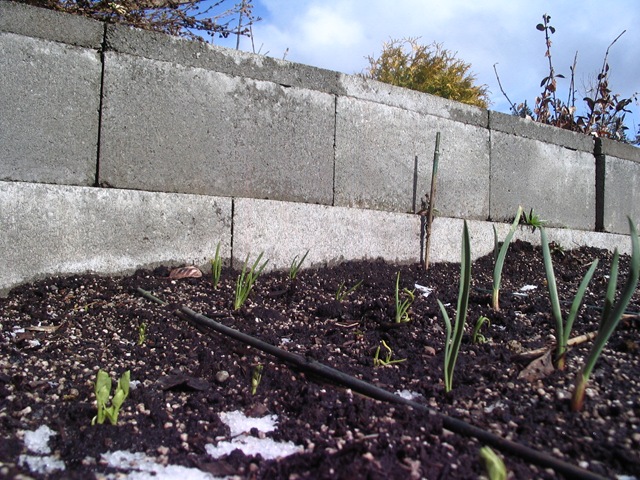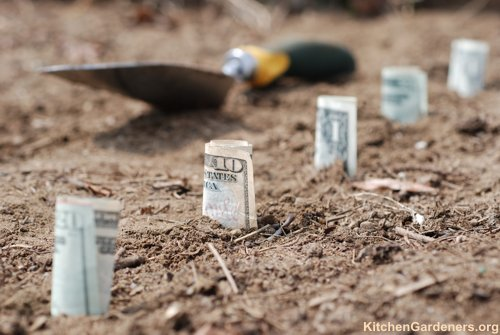Finish outdoor seed planting with coffee grounds
15.2 years ago garlic bulbs, onions, outdoor seed starting
It has been a blessing that the competition for free coffee grounds at the Starbucks at my work has increased now the weather warmed up and I have freed from the temptation to grab yet another free shiny silver bag of grounds. The reason is, I have put four bags in my compost, worked generous amounts into my vegetable garden and I still have six bags left. Now I am looking at inventive ways to use the rest up. I tried mixing with perlite to make a cheap potting soil (failed still no room for roots) but I believe I have come across one success I thought I would share.
When you are finished planting seeds outdoors apply a thin layer of coffee grounds. This will deter slugs from going after your new seedlings and keep cats from mistaking your nicely loosened and raked soil for their kitty litter.
I have done this for my larger seed plants (peas, garlic, onions, cilantro) but for the small seed plants (carrots, lettuce, spinach) I used the coffee grounds as a seed covering.
So far the results are great. All of my peas/garlic/onions/spinach have sprouted with no signs of pests (four-legged nor zero-legged).
Tags: cheap, cilantro, coffee grounds, compost, garden seeds, garlic bulbs, led, outdoor plants, vegetables
Growing in dirt outside
15.2 years ago cilantro, cucumbers, garlic bulbs, indoor growbox, onions, outdoor seed starting, peas, tomato
I haven’t done many posts in a while about regular old gardening in actual dirt so figured a good time to do an update. Though I enjoy indoor seed starting in my LED grow box and computerized grow box, some plants need to be started outdoors. Today my daughters and I planted the last these plants for fall outdoor planting.
A few weeks ago, we planted garlic, onions, spinach, and peas which are doing well. I love growing these plants no matter how late your spring comes these plants are hardy they are pretty hard to kill off.
Today we planted carrots, lettuce, and cilantro leaving a little space left to do some successive cilantro planting in a couple weeks to ensure I have enough for salsa by the time the tomatoes are ready this summer.
Speaking of tomatoes, they along with jalapeño peppers, and cucumbers (actually flowering) are doing great in the computerized grow box. In the LED grow box I have pumpkin, Black Eyed Susan, small sunflowers, and Purple Coneflowers using Grodan Gro-Blocks.
Nice to finally see some stuff in the ground though still hoping the weather gets better before my cucumbers try to escape the grow box.
Tags: cheap, cilantro, garden seeds, garlic bulbs, growbox, led, outdoor plants, pepper plants, salsa garden, tomato plants, vegetables
The most profitable plants in your vegetable garden
15.4 years ago cheap, cilantro, garlic bulbs, organic, seedling, seeds, vertical gardening, winter garden
Many vegetables can be expensive to purchase by growing the most expensive vegetables in your garden and buying the least inexpensive vegetables at your grocery store you can easily help drop your food budget. This especially important for people like me with very limited space to grow everything that I consume.
It may be impossible to put a price on the satisfaction of bringing in a basket of produce fresh from your garden. As well as the enhanced flavors from having truly fresh produce from your garden compared to that of your local supermarket. Though when I was harvesting my potatoes this summer with my daughter I did have the thought, Would it have been smarter for me to grow something else in this space? I estimate out of the 4-5 square feet I used for these plants I probably got about $4-5 worth of potatoes.
I did a little research first to determine yields of various plants per square foot and secondly what the value (organic supermarket prices USD) of the yielded produce at harvest. Given I am a city dweller with a fairly small footprint for my vegetable garden (about 30-35 square feet) making decisions on what to buy at the supermarket and what to grow in the garden may be a huge money saver with just a few dollars invested in some seeds for your vegetable garden
Now from the results below you can see the winners for the most produce value per square foot are many of the leafy green vegetables/herbs (cilantro, lettuce, chives, dill, Swiss chard) next comes many of the larger vine plants (tomatoes, squash, pumpkins, peas) with many of the root plants taking up the rear. Now much of this makes sense where many of the vine plants grow on trellises and are allowed to spread, which I guess is sort of cheating the square foot rule but I will let it slide. Compared to the root plants whose production is entirely dependent on the space allowed in square footage they have to grow as well as these are normally inexpensive produce items to begin with.
| Vegetable | USD Value/SF |
| Cilantro | $ 21.20 |
| Arugula-Roquette | $ 20.92 |
| Green Salad Mix | $ 17.55 |
| Chives | $ 16.40 |
| Dill | $ 16.40 |
| Lettuce | $ 16.20 |
| Tomato, Cherry, small & medium | $ 15.57 |
| Turnip | $ 9.90 |
| Tomato, large | $ 9.50 |
| Squash, Winter | $ 8.40 |
| Tomatillo | $ 8.00 |
| Cucumber | $ 7.74 |
| Basil | $ 6.63 |
| Radish, Red | $ 6.22 |
| Pumpkin | $ 6.20 |
| Chard, Swiss | $ 6.14 |
| Celery | $ 6.00 |
| Squash, Summer | $ 5.96 |
| Choi | $ 5.70 |
| Peas, Snow | $ 4.50 |
| Pepper, Jalapeno | $ 4.50 |
| Squash, Summer, Zucchini | $ 4.17 |
| Onion, Bunching | $ 4.14 |
| Pepper, Bell | $ 3.60 |
| Brussels Sprouts | $ 3.59 |
| Carrots | $ 3.56 |
| Rhubarb | $ 3.25 |
| Squash, Winter, Butternut | $ 3.20 |
| Kale | $ 3.07 |
| Grass, Lemon | $ 3.00 |
| Peas, English | $ 3.00 |
| Onion, Bulb | $ 2.63 |
| Radish, White | $ 2.60 |
| Bean, Bush | $ 2.51 |
| Peas, Edible Pod | $ 2.50 |
| Artichoke, Globe | $ 2.40 |
| Cabbage, Chinese Napa | $ 2.24 |
| Squash, Winter, Delicata | $ 2.10 |
| Spinach, Spring/Fall | $ 1.80 |
| Leeks | $ 1.75 |
| Potatoes | $ 1.50 |
| Parsnips | $ 1.50 |
| Garlic | $ 1.37 |
| Squash, Summer, Yellow | $ 1.34 |
| Parsley | $ 1.31 |
| Corn | $ 1.25 |
| Squash, Winter, Acorn | $ 1.20 |
| Squash, Winter, Hubbard | $ 1.20 |
| Eggplant | $ 1.10 |
| Greens, Mustard | $ 1.10 |
| Rutabaga | $ 1.00 |
| Beet | $ 0.89 |
| Cabbage, Savoy | $ 0.80 |
| Broccoli | $ 0.80 |
| Kohlrabi | $ 0.75 |
| Cauliflower | $ 0.60 |
| Broccoli, Chinese | $ 0.60 |
| Cabbage | $ 0.50 |
Sources: http://www.mcgoodwin.net/pages/ppatch.html for plant yield information, http://shop.safeway.com for current produce prices
Now even with this information I will still plan on growing some onions and garlic since I more than likely would be forced to use dehydrated alternatives due to being too lazy to drive to the supermarket to buy fresh varieties. Though I may be adding some more herbs/greens to my garden this year.
One important thing to remember is you still have to eat the vegetables, throwing $20 worth or arugula or cilantro into the compost bin is not exactly a sound investment. You can also get higher yields by growing vertically, but don’t forget those tall plants produce a larger shadow so you may still need some extra ground space to support these alternate growing methods.
So go out and get some cheap vegetable seeds (or in many cases free) and plant some profitable vegetables in your backyard/patio garden this spring.
Tags: cilantro, compost, garlic bulbs, herb garden, organic vegetables, outdoor plants, pepper plants, tomato plants, vegetables
Garden teriyaki sauce recipe
15.9 years ago garlic bulbs, growing challenge

This is the first year I have grown garlic inspired by the Growing Challenge so now I want to find some good uses for this new addition. For Independence Day we are having a typical BBQ (teriyaki chicken burgers) and we ran out of teriyaki sauce seemed like a logical thing to attempt. Must say the improvised recipe was really easy and tasted much better than the stuff we got from the store (much less salty) I have kids so I only used a small pinch of red pepper flakes but with those with a taste for extra spice recommend adding at least a half a teaspoon.
Garden teriyaki sauce recipe
- 1 tsp olive oil
- 1 tsp of chopped or pressed garlic
- 1 tsp of fresh grated ginger (1/2 tsp powdered ginger)
- 1/2 cup soy sauce
- 1/2 cup brown sugar
- 1/4 cup honey
- 1 cup water
- red pepper flakes (to taste)
Directions: Warm oil is sauce pan at medium heat and add garlic and ginger to oil. Stir for 2 minutes and add remaining ingredients. Reduce heat and stir until sugar dissolves. Make 12 ounces of teriyaki sauce.
Tags: garlic bulbs, pepper plants
Slugs eating my garlic
16 years ago garlic bulbs, slugs

The word is slugs are supposed to hate garlic, guess no one told this guy. The reality is they do not like the bulb underground apparently the garlic leaves are delicious. Appears that I need to step up my war with the slugs.
Tags: cheap, garlic bulbs, vegetables
How to grow garlic in your garden
16.1 years ago garlic bulbs, growing challenge

My experiment of planting organic garlic which I bought from my local produce section of my grocery store seems to be working well. If you want to try this yourself here are some hopefully easy to follow steps:
- Buy some good looking garlic at your grocery store (I chose organic since I made an assumption there was a decreased chance that it was treated to prevent growth)
- When you are ready to plant, carefully break open the garlic and separate the tear shaped cloves.
- Take the largest cloves and plant in well cultivated soil 2 inches deep and 4 inches apart with pointed end up, these will be for your full garlic bulbs.
- Take the smaller cloves and either use in some spaghetti sauce or plant them in your garden 1-2 inches apart to harvest as baby garlic (think green onions, but strong garlic flavor)
- Fertilize with a balanced fertilizer (or bone meal) during planting but avoid fertilizing after that point since you don’t want to encourage too much foliage growth by having an abundance of nitrogen in the soil and allow the plant to use its energy to grow a big bulb.
- When the foliage on the “scapes” began to completely uncurl you can cut them off and use them on salads, scrambled eggs, or even garlic scape pesto. I would recommend leaving a couple of your garlic plants with scape attached since it also works a natural indicator of when your garlic is ready to harvest. When the lower third of the scape is light brown (the color your expect for garlic) it is ready to dig out.
- Take any cracked bulbs and use them immediately, take the remaining bulbs and wash off any dirt and let them dry for 2-3 weeks depending on how dry your climate is.
- Once cured hang in a mesh bag or braid the garlic and given proper airflow and temperature (50-70 degrees) your garlic should last for 6 months (if not eaten by then)
As you can see growing garlic is pretty low maintenance and I am definitely looking forward to using it to my salsa this fall.
Tags: cheap, garden seeds, garlic bulbs, led, organic vegetables, outdoor plants, salsa garden, vegetables




